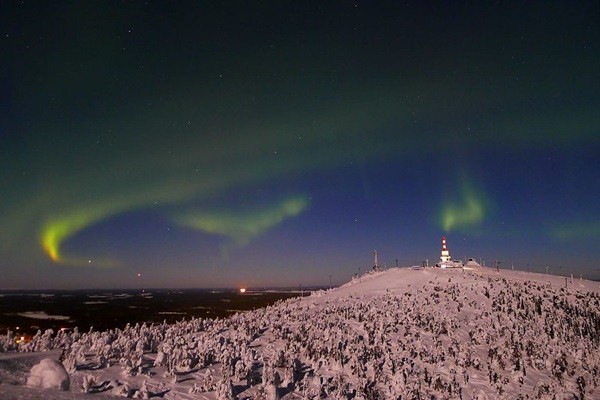
Northern lights: Jupiter and Venus set amid the northern lights as seen from Ruka, Finland, in early 2012.
Friday, December 17
2021’s best comet, C/2021 A1 (Leonard), floats just 5° below Venus in the evening sky tonight. Depending on the Leonard’s current magnitude, it may be just visible to the naked eye in the falling twilight.
To catch the stunning scene, turn southwest after sunset. You absolutely won’t be able to miss Venus’ magnitude –4.9 glow, still 20° above the horizon as the Sun disappears. Let the sky begin to darken and your eyes adjust with it as you start scanning for Leonard’s faint, fuzzy coma.
Binoculars will greatly aid your search, but make sure the Sun is completely gone from the sky before pulling them out. If you’re an astrophotographer, you won’t want to miss this picturesque view, and photographs will certainly bring out Leonard’s still-bright dust tail and enhance the amount of its central coma you can see. The comet sets just under two hours after the Sun, so depending on how clear your horizon is, there’s a bit of time to let the sky darken for better contrast against the comet’s dim glow.
The Moon reaches apogee, the farthest point from Earth in its orbit, at 9:15 P.M. EST. Our satellite will then sit 252,475 miles (406,319 km) away.
Sunrise: 7:16 A.M.
Sunset: 4:36 P.M.
Moonrise: 3:32 P.M.
Moonset: 5:56 A.M.
Moon Phase: Waxing gibbous (98%)
*Times for sunrise, sunset, moonrise, and moonset are given in local time from 40° N 90° W. The Moon’s illumination is given at 12 P.M. local time from the same location.
Saturday, December 18
Venus reaches its stationary point against the background stars today 6 A.M. EST. Visible in the dusk sky as a blazing evening star, the planet currently sits in Sagittarius the Archer, close to his northeastern border with Capricornus the Sea Goat. The latter is where you’ll find the majestic ringed planet Saturn all month, glowing a dim magnitude 0.6. The pair came closest (14°) late last week and will end December 19° apart as Venus begins slowly arcing away again.
Venus currently shows a 14-percent-lit disk that some 51" wide. Continue watching it throughout the month to see that phase diminish but its size grow. Earth’s sister planet will end the year just 2 percent lit and 61" wide on the sky.
And speaking of Venus, Comet C/2021 A1 (Leonard) passes within 2.6 million miles (4.2 million km) of the planet today on its way toward an early January perihelion.
Full Moon occurs at 11:35 P.M. EST. December’s Full Moon is also called the Cold Moon, thanks to its timing during the chilly winter season in the Northern Hemisphere. The Moon will appear Full both tonight and tomorrow night, casting its bright light throughout the nighttime sky.
Sunrise: 7:17 A.M.
Sunset: 4:37 P.M.
Moonrise: 4:11 P.M.
Moonset: 6:55 A.M.
Moon Phase: Full
Sunday, December 19
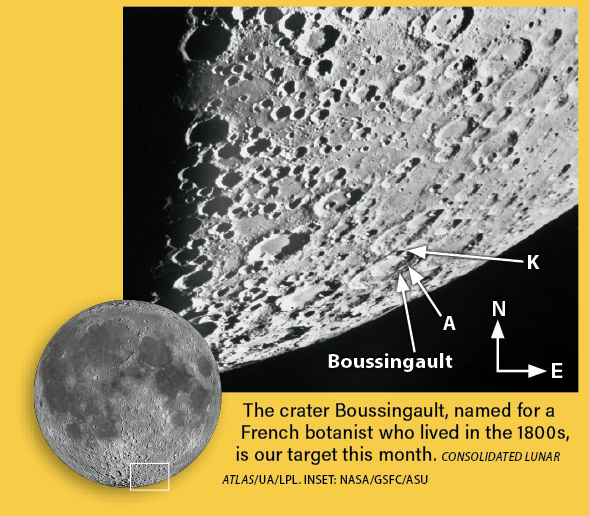
This evening, let’s take advantage of the Full Moon as we search out the crater Boussingault, located in the lunar southeast (our satellite’s lower right as we see it from Earth). Use a telescope to zoom in on the cratered southern region, where the circular features often appear elongated thanks to our foreshortened view of the lunar limb.
Inside the larger Boussingault is a second crater — the 45-mile-wide (72 kilometers) Boussingault A — which gives the feature a double-walled appearance. Smaller Boussingault K (18 miles [29 km] wide) sits on Boussingault’s northern rim. Spotting A and K will ensure you’re in the right place on the lunar surface. Enjoy these craters’ complex terrain and dark shadows, and come back over the next few nights — up until the 21st — to see how the dynamic view has changed.
Take note that the bright moonlight will temporarily eliminate your eyes’ dark adaptation, so plan your lunar observing for after you’ve searched out any fainter objects you might like to enjoy.
Sunrise: 7:18 A.M.
Sunset: 4:37 P.M.
Moonrise: 4:57 P.M.
Moonset: 7:52 A.M.
Moon Phase: Full
Monday, December 20
Although there’s a bright Moon in Gemini this morning, let’s focus across the sky on Boötes, still about 35° high three hours before sunrise.
Boötes is home to several great telescopic targets, including the double star Izar (Epsilon [ϵ] Bootis). This pair of stars has also been called Pulcherrima, which is Latin for “the most beautiful.” That’s because this close pair — separated by just 3" — is considered by many to be one of the best-looking double stars in the sky. Its two components are a brighter (magnitude 2.7) orange K-type star and a dimmer (magnitude 5.1) but hotter white A-type star. Their contrasting colors can look different to different viewers, with descriptions ranging from blue and gold to yellow and green.
To find Izar, look 10.4° northeast of blazing magnitude –0.1 Arcturus, which itself is a gorgeous red-gold giant star that shows fine color through binoculars or a telescope. Note that Izar can be difficult to separate; you’ll want a night of good seeing — which, fortunately, is relatively easy to come by during the cold, clear winter months.
Sunrise: 7:18 A.M.
Sunset: 4:37 P.M.
Moonrise: 5:50 P.M.
Moonset: 8:43 A.M.
Moon Phase: Waning gibbous (98%)
Tuesday, December 21
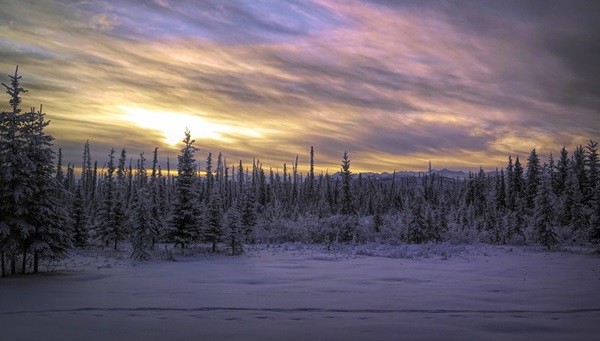
High Noon: This image captures the landscape at high noon on the winter solstice in 2019 from near Anchorage, Alaska. The length of that day was a mere 5 hours 6 minutes 19 seconds.
The winter solstice occurs at 10:59 A.M. EST. At that exact moment, the Sun sits directly above the Tropic of Capricorn, located at latitude 23.5° south on the globe. (Note, however, that this does not correlate to the Sun being located in the constellation Capricornus in the sky. It’s currently located in Sagittarius.)
This is the time that marks the true beginning of winter for those in the Northern Hemisphere. It is typically the shortest day and the longest night of the year for those above the equator as well, although the exact amount of daylight you receive depends upon your latitude.
Thanks to the celestial geometry at play today, it’s also the day the Sun rises and sets the farthest south. Our star’s southerly position also produces the longest shadows at local noon on the solstice. You can test this for yourself by marking the length of a given shadow, perhaps from building, lawn ornament, or other stationary landmark, for several days leading up to and after the 21st.
Sunrise: 7:19 A.M.
Sunset: 4:38 P.M.
Moonrise: 6:48 P.M.
Moonset: 9:29 A.M.
Moon Phase: Waning gibbous (94%)
Wednesday, December 22
If you’re up early this morning, check out Canes Venatici the Hunting Dogs, a circumpolar constellation nestled beneath the arch of the Big Dipper’s handle.
These canines, often depicted as belonging to Boötes the Herdsman, are home to several excellent deep-sky targets. Today, let’s pick M94, the constellation’s brightest galaxy. Glowing at magnitude 8.2 and spanning about 7' by 3', you’ll want a larger scope to make out much detail. In an 8-inch, you can pick up both the bright nucleus and about 30' of this spiral galaxy’s disk. Go even larger, and you’ll start to make out its tightly wound arms, although you may want to wait for a later date when there’s less moonlight to boost your chances of seeing these faint structures.
You can get to M94 easily by first locating Alpha (α) Canum Venticorum, a 3rd-magnitude star also known as Cor Caroli. But this isn’t a single star — it’s a binary system separated by nearly 20", which is easy to resolve even in a small telescope. From this system, simply look 3° north-northwest and you’ll land right on M94.
If this galaxy intrigues you, remember its position. As we move through winter and into spring, its visibility will grow more and more favorable as it switches to appear high in the evening sky by April.
Sunrise: 7:19 A.M.
Sunset: 4:38 P.M.
Moonrise: 7:50 P.M.
Moonset: 10:07 A.M.
Moon Phase: Waning gibbous (89%)
Thursday December 23
Our night sky hosts 88 official constellations recognized by the International Astronomical Union. But there are many more asterisms, or unofficial patterns of stars, that amateur and professional astronomers alike often use. Tonight, step outside to enjoy one of the largest as it floats high overhead these winter nights: the Winter Hexagon.
Start your tour of this grand shape at Rigel, Orion’s bright knee. Then move clockwise to land on Sirius, the Dog Star, and Procyon in Canis Major’s smaller neighbor, Canis Minor. The heads of Gemini the Twins are next — first Pollux, then Castor — before moving on to Capella in Auriga and Aldebaran, the eye of Taurus the Bull. Link back up with Rigel to close out the hexagon.
Two of the hexagon’s stars also feature in the Winter Triangle, the cold-weather counterpart of the famous Summer Triangle. To find this three-sided asterism, connect Sirius and Procyon not to Rigel, but instead to Betelgeuse, the shoulder of Orion the Hunter.
Southwest of Betelgeuse is perhaps one of the sky’s most famous (and simple) asterisms: Orion’s Belt, formed by a line drawn through the three stars Alnitak, Alnilam, and Mintaka.
Sunrise: 7:20 A.M.
Sunset: 4:39 P.M.
Moonrise: 8:53 P.M.
Moonset: 10:41 A.M.
Moon Phase: Waning gibbous (82%)
Friday, December 24
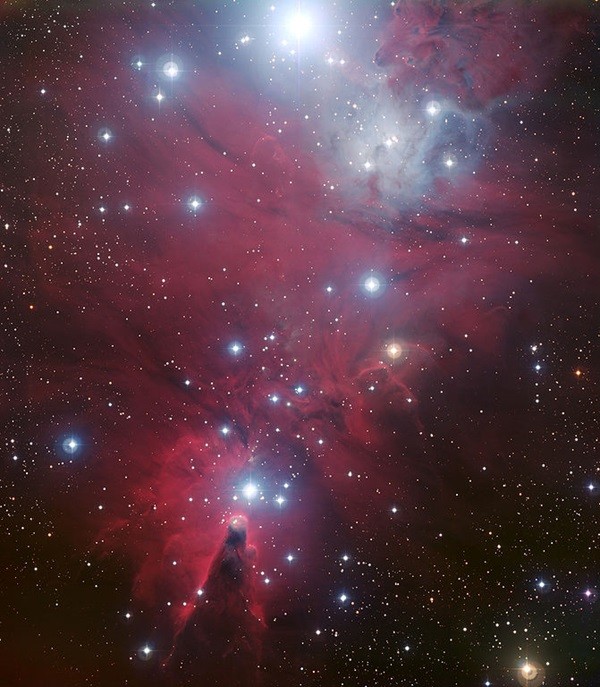
Celestial Christmas tree: The Christmas Tree Cluster floats upside-down above the Cone Nebula in Monoceros. The bright star just off the tip of the Cone is the top of the tree, while the brightest star in the frame — S Monocerotis — marks the trunk.
In celebration of the upcoming holiday, let’s enjoy the Christmas Tree Cluster tonight. Also cataloged as NGC 2264, this young group of stars is located between the Fox Fur and Cone nebulae in Monoceros the Unicorn. For the best views, you’ll want to wait a few hours after sunset but before the Moon has risen to get the darkest skies.
The Christmas Tree Cluster is located in northern Monoceros, about halfway on a line drawn between Gomeisa in Canis Minor and Betelgeuse in Orion. Perhaps the easiest way to find it is to locate 2nd-magnitude Alhena in Gemini and drop about 6.5° south. The triangular cluster of stars is inverted with respect to the Cone Nebula, so their narrow tips are adjacent. Under good conditions, you can spot this small cluster with the naked eye; otherwise, binoculars or a small telescope will easily bring it out. Note that the tree may appear upside-down or sideways in your field of view, depending on the layout of your optics and its position in the sky.
The Christmas Tree Cluster even hides another wintry treat: the so-called Stellar Snowflake Cluster. This is a group of young stars scattered on the sky so they look a bit like the arms of a snowflake. Unfortunately, these stars are still embedded within the dense gas and dust that formed them, and remain hidden from your eyes in visible light. They were identified by the Spitzer Space Telescope, whose forte was to look at the longer wavelengths in the infrared portion of the spectrum.
Sunrise: 7:20 A.M.
Sunset: 4:40 P.M.
Moonrise: 9:58 P.M.
Moonset: 11:10 A.M.
Moon Phase: Waning gibbous (74%)
Saturday, December 25
Mars passes from Scorpius into Ophiuchus today and stands close to its noted rival, Antares, in the predawn sky. An hour before sunrise, they’re 4.7° apart, with Mars north (above and to the left) of Antares. Mars glows at magnitude 1.6, while Antares is a slightly brighter magnitude 1.1. Compare and contrast their colors as they shine together in the lightening sky.
Through a telescope, the Red Planet presents a tiny, 4"-wide disk. Mars is now nearly 2.4 astronomical units (AU) from Earth, where 1 AU is the average Earth-Sun distance. By December next year, that disk will have grown to span some 17" on our sky, with Mars shining a much brighter magnitude –1.9.
Slightly higher in the sky are the stars of Libra the Balance. Zubenelgenubi, the constellation’s magnitude 2.8 alpha star, can be split into two with binoculars. Although it carries the alpha designation, it’s dimmer than magnitude 2.6 Beta (β) Librae, also known as Zubenesch.
Sunrise: 7:20 A.M.
Sunset: 4:40 P.M.
Moonrise: 11:02 P.M.
Moonset: 11:36 A.M.
Moon Phase: Waning gibbous (64%)
Sunday, December 26
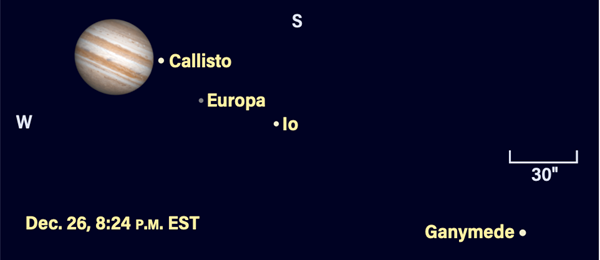
Reappearing act: At 8:24 P.M. EST on the 26th, Europa is poised to emerge from Jupiter’s large, dark shadow. Callisto, meanwhile, is closing in and will begin transiting the disk at 8:53 P.M. EST.
Mars passes 5° due north of Antares at 1 P.M. EST. Although daylight will hide them at that time, you can catch them again early this morning, about 10° above the horizon 30 minutes before sunrise.
Meanwhile, evening observers should zero in on Jupiter after sunset, where the Galilean moons are putting on a show. As darkness falls, you’ll see just three of the four moons: Callisto closest to the planet’s eastern limb, with Io and then Ganymede farther east. But keep an eye on things over the next few hours: By 8:24 P.M. EST, Europa is just poised to emerge from Jupiter’s long, dark shadow. It will reappear roughly 26" from the eastern limb — farther from the limb than Callisto now sits. That’s because the planet’s shadow stretches far out behind it, while Callisto is approaching from the front. It will begin transiting the disk at 8:53 P.M. EST and should be visible as a bright spot against the cloud tops alongside the Great Red Spot, also rotating across the visible face of the planet at the same time. Jupiter will set around 9 P.M. local time with Callisto still crossing its 36"-wide disk.
Last Quarter Moon also occurs tonight, with our satellite reaching this phase at 9:24 P.M. EST
Sunrise: 7:21 A.M.
Sunset: 4:41 P.M.
Moonrise: —
Moonset: 12:01 P.M.
Moon Phase: Waning gibbous (54%)
Monday, December 27
The constellation Lynx is climbing above the horizon at sunset tonight. Wait a few hours and then take advantage of the moonless sky before midnight to catch a glimpse of NGC 2419, the Intergalactic Wanderer.
This globular cluster earned is strange name thanks to its distance — some 300,000 light-years away. That’s nearly twice the distance to the Milky Way’s largest satellite galaxy, the Large Magellanic Cloud. Initially, astronomers weren’t sure this cluster orbited the Milky Way at all, but have since discovered that it does. Nonetheless, that vast distance is the reason NGC 2419 appears so faint (roughly magnitude 9, so opt for a 4-inch scope or larger), as it is physically quite large and intrinsically bright.
To find this compact cluster, it’s actually easier to use a guidepost in nearby Gemini: The bright star Castor sits 7° due south of the Intergalactic Wanderer. While you’re in the area, perhaps take some time to enjoy Castor itself, whose bright (2nd and 3rd magnitude, respectively) A and B components are just a few arcseconds apart. Castor C lies 1.2' to their south — see if you can also spot this 9th-magnitude star. Each of these three stars is a binary, bringing the total number of stars in this system to six.
Sunrise: 7:21 A.M.
Sunset: 4:42 P.M.
Moonrise: 12:08 A.M.
Moonset: 12:25 P.M.
Moon Phase: Waning crescent (43%)
Tuesday, December 28
Mercury has finally emerged from the Sun’s glare and is visible in the evening. Tonight, the solar system’s smallest planet passes 4° south of Venus at 8 P.M. EST. The two planets are below the horizon then, so instead catch them just after sunset, when they’re 4.2° apart and about 7° high in the southwest 30 minutes after the Sun disappears.
Venus is much brighter — magnitude –4.5 — while tiny Mercury still glows at a decent magnitude –0.8. It should be easy to catch both in binoculars or zoom in on one at a time with a telescope. Mercury’s face spans just 6" and is 84 percent lit; Venus is a much wider 59" but only 4 percent lit.
In the coming days, Mercury will continue to track higher in the sky each evening, becoming easier to catch for longer after sunset.
Sunrise: 7:21 A.M.
Sunset: 4:42 P.M.
Moonrise: 1:17 A.M.
Moonset: 12:51 P.M.
Moon Phase: Waning crescent (32%)
Wednesday, December 29
Rising with Gemini the Twins after sunset tonight is the open cluster Collinder 89. According to Astronomy columnist Stephen James O’Meara, this cluster could also be called the Peek-a-Boo Cluster because so many people see it without realizing!
The 20 or so stars of Collinder 89 shine with a total apparent magnitude of 5.7. They’re located in the 0.7°-wide space between the two brighter stars 9 and 12 Geminorum, which are magnitude 6 and 7, respectively. If you need a brighter signpost, start at Mu (μ) Gem, which shines at magnitude 2.9, and look 1.5° northwest. The best way to see this target is with binoculars or a low-power telescope eyepiece.
Take your time and enjoy this loose elliptical cluster — and then look (without changing your field of view) closer at 12 Gem to note that it is veiled in a 30'-wide reflection nebula: IC 444. If you can’t see it, make note of the field and bump up your aperture or power to try again. Visual observers will likely only see the brightest 10' of this nebula, but astroimagers will be able to pick up the full extent of its glow.
Sunrise: 7:22 A.M.
Sunset: 4:43 P.M.
Moonrise: 2:28 A.M.
Moonset: 1:21 P.M.
Moon Phase: Waning crescent (22%)
Thursday, December 30
Andromeda the Princess is high in the northern sky after sunset tonight — the perfect opportunity to hunt down the appropriately wintry themed Blue Snowball. Also cataloged as NGC 7662, this object is a planetary nebula created by a dying Sun-like star. As the star has aged, it’s blown off its outer layers into a spherical shell, subsequently lighting up this tenuous gas.
The Blue Snowball is about 2,200 light-years away. At that distance, it spans about 30" on the sky and glows at magnitude 8.3 — easy for binoculars or a small telescope. You’ll find it about 4.5° due east of magnitude 3.6 Omicron (ο) Andromedae, situated near this long constellation’s western border. Take a look for yourself and enjoy this nebula’s namesake bright blue color.
Sunrise: 7:22 A.M.
Sunset: 4:44 P.M.
Moonrise: 3:44 A.M.
Moonset: 1:56 P.M.
Moon Phase: Waning crescent (13%)
Friday, December 31
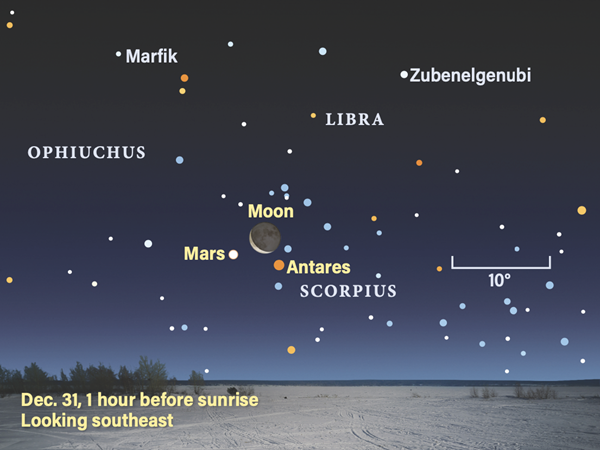
Red-letter day: Mars and the Moon give 2021 a grand send-off in Scorpius, where they hang near the famously red-hued star Antares.
The Moon and planets are aligning to give 2021 the perfect sendoff, regardless of whether your preference is to get up early or stay out late.
First, our satellite passes 0.9° south of Mars at 3 P.M. EST. Both are visible several hours earlier this morning, just 4° apart in the southeastern sky an hour before sunrise. Look especially for a hint of earthshine — sunlight reflecting off our planet to illuminate the portion of the Moon’s face still in shadow — on the delicate crescent Moon. Mars’ magnitude 1.5 disk now sits just over 5° northeast of Antares. Together with the Moon, the three form a small isosceles triangle on the sky.
If evening viewing better fits your New Year’s Eve plans, there are four naked-eye planets now congregating in the dusk sky, setting slowly after the Sun: Venus, Mercury, Saturn, and Jupiter.
Magnitude –4.3 Venus now stands lowest on the sky, 11° high at sunset. Mercury, at magnitude –0.8, is 1° higher. Saturn, still magnitude 0.6 in Capricornus, is nearly 19° due east of Venus. Wait for a darker sky to catch its largest moon, Titan, floating just over 1' to the ringed planet’s southeast tonight. Finally, highest in the sky in Aquarius, magnitude –2.1 Jupiter is just over 18.5° east of Saturn and sits 35° high at sunset. It is nearly even with bright Altair in Aquila, some 40° northwest of the planet and the first of the Summer Triangle’s three stars to set tonight, around 7:45 P.M. local time. The Triangle’s other two stars are gone by midnight — a far cry from the height of summer, when they fly high overhead at this time.
Neptune and Uranus are also up tonight — the former in Capricornus and magnitude 7.8, and the latter in Aries at magnitude 5.7. Both make great targets for binoculars or a telescope if you’re looking to round out your last solar system tour of the year.
Sunrise: 7:22 A.M.
Sunset: 4:45 P.M.
Moonrise: 5:02 A.M.
Moonset: 2:39 P.M.
Moon Phase: Waning crescent (6%)
Source: astronomy.com